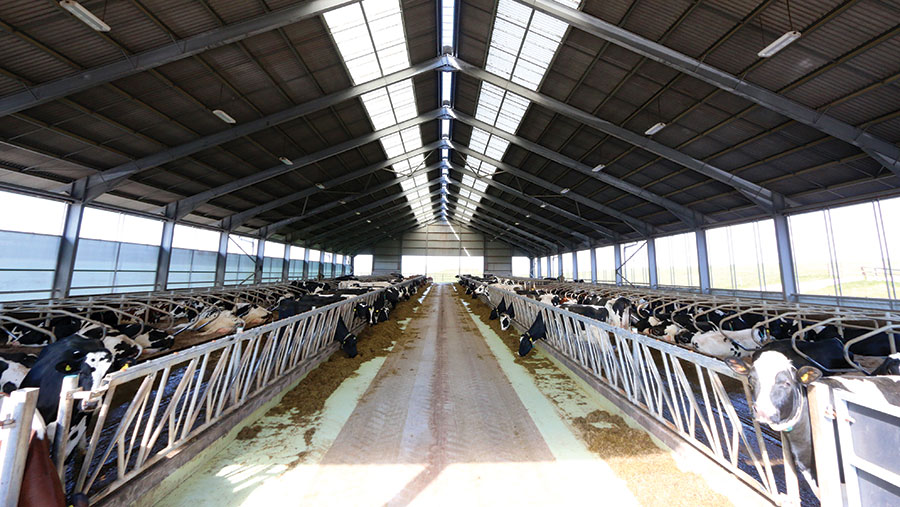6 housing tips for better dairy production and welfare

A few inexpensive, practical changes to the housing environment can make all the difference to the health, welfare and productivity of a dairy herd says Alice Miller of Friars Moor Livestock Health.
The productive dairy cow is more likely to achieve her genetic potential when allowed to thrive in the best environment.
Reviewing the dairy housing environment on your farm may highlight areas that need improvement.
The following six key areas should be considered.
See also: 6 fresh cow checks to prevent problems after calving
1. Light levels
The level of light exposure at certain production stages can have beneficial effects on milk production. The documented research findings reflect what we see in practice.
A long photoperiod (18 hours), compared to natural day length, can increase milk yield by an average of two litres/day.
However, shorter day lengths are recommended for dry cows.
Reduced light hours at eight hours during a 60-day dry period can increase milk yield in the following lactation by 3.2kg/day.
Light levels within the shed should be at least 200 lux during the day, and in periods of darkness levels should not be less than 30 lux to ensure cows can still see to move around the building.
The best buildings expose cows to maximum natural daylight levels as well as having the option of ample artificial LED lighting, so light levels can be adjusted accordingly.
But it is worth considering that where skylights are used to increase daylight levels, ambient temperature can also rise in a “greenhouse” effect.
2. Surveillance

There has been a rise in the use of surveillance cameras on farms, with features that allow 360deg views, ability to zoom and night vision.
These are becoming invaluable tools in calving areas.
Remote surveillance avoids stressful disturbance that can delay the natural onset of calving.
Equally, unnecessary calf losses can be avoided with earlier intervention and assistance where cows are seen to be experiencing difficulties.
Cameras can also be useful in other areas, for example, collecting yards to help with oestrus detection.
3. Hygiene
Adult cattle can shed high levels of bacteria such as Johne’s, salmonella and E coli, viruses such as coronavirus and rotavirus, and parasites, including cryptosporidium, in their faeces.
It is therefore important that sick cows are not left in calving pens, since levels of contamination can increase quickly and any calves inhabiting the pen will be at risk.
Often, calving pens are sited close to the collecting yard or parlour, where they become contaminated with slurry or effluent run-off, which is another source of infection for calves.
It is important that calves are not left in the calving pens for too long to help minimise infection risks.
Calving pens should be regularly steam-cleaned, organic matter removed, allowed to dry and fresh bedding replaced.
Detergents will help remove engrained dirt and biofilms, where a multitude of pathogens can survive for months.
Disinfectants should be used after detergents at the specified dilution rate.
4. Enrichment and space
More farms are exploring the idea of offering enrichment activities for adult cattle and youngstock.
Brushes for cows and calves are in constant use when seen on farm visits, but other novel ideas offer opportunities for play, such as punch bags, tractor tyres, hay bales and padded posts.
5. Comfort
Cow comfort has significant impact on welfare and health.
Cows that spend at least 12 hours/day with a dry and comfortable place to lie will be happier and have reduced mastitis and lameness risks.
Whether loosely housed or in cubicle sheds, there should be allowance for extra lying space. (See more on cubicle sheds on the AHDB website.)
The bedding substrate should be at least 6in deep to ensure cows are comfortable, avoid hock lesions and reduce cubicle refusals.
The use of rubber matting at feed faces, collecting yards and in the parlour has been found to reduce lameness.
It is important that floor surfaces are not slippery and re-grooved regularly to avoid cow injuries and encourage confidence to display bulling behaviour safely.
6. Heat stress
The effect of heat stress on cattle has been well documented.
The upper critical temperature (UCT) of adult cattle is 25C – above this, cattle are at risk of heat stress.
It is important to consider UCT is even lower when humidity levels increase.
Heat stress is a welfare issue but will also have detrimental effects, including reduced dry matter intake, milk yield reductions, poor fertility, increased embryonic loss and more clinical mastitis.
Heat stress can be avoided by ensuring buildings are well ventilated, with unrestricted air inlets and outlets.
Where there is not enough natural ventilation, mechanical ventilation systems should be considered.
Buildings that work best are those where you can control ventilation to suit daily temperature, humidity and wind speed changes, to ensure cows can always avoid thermal extremes.
Placing fans in areas where cattle are grouped and natural ventilation maybe restricted, such as the collecting yard and parlour, should also be considered and can make a huge positive difference for the cow.
It is also important to consider that a cow’s water intake requirement may increase by 10-20% in warmer conditions, with lactating cows requiring 100-130 litres/day.
Allowing enough trough space is therefore critical.
Each month an XLVets practice offers practical help. Here, we get advice on improving dairy housing to boost production and health with Alice Miller of Friars Moor Livestock Health.
